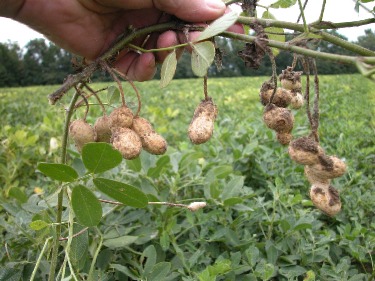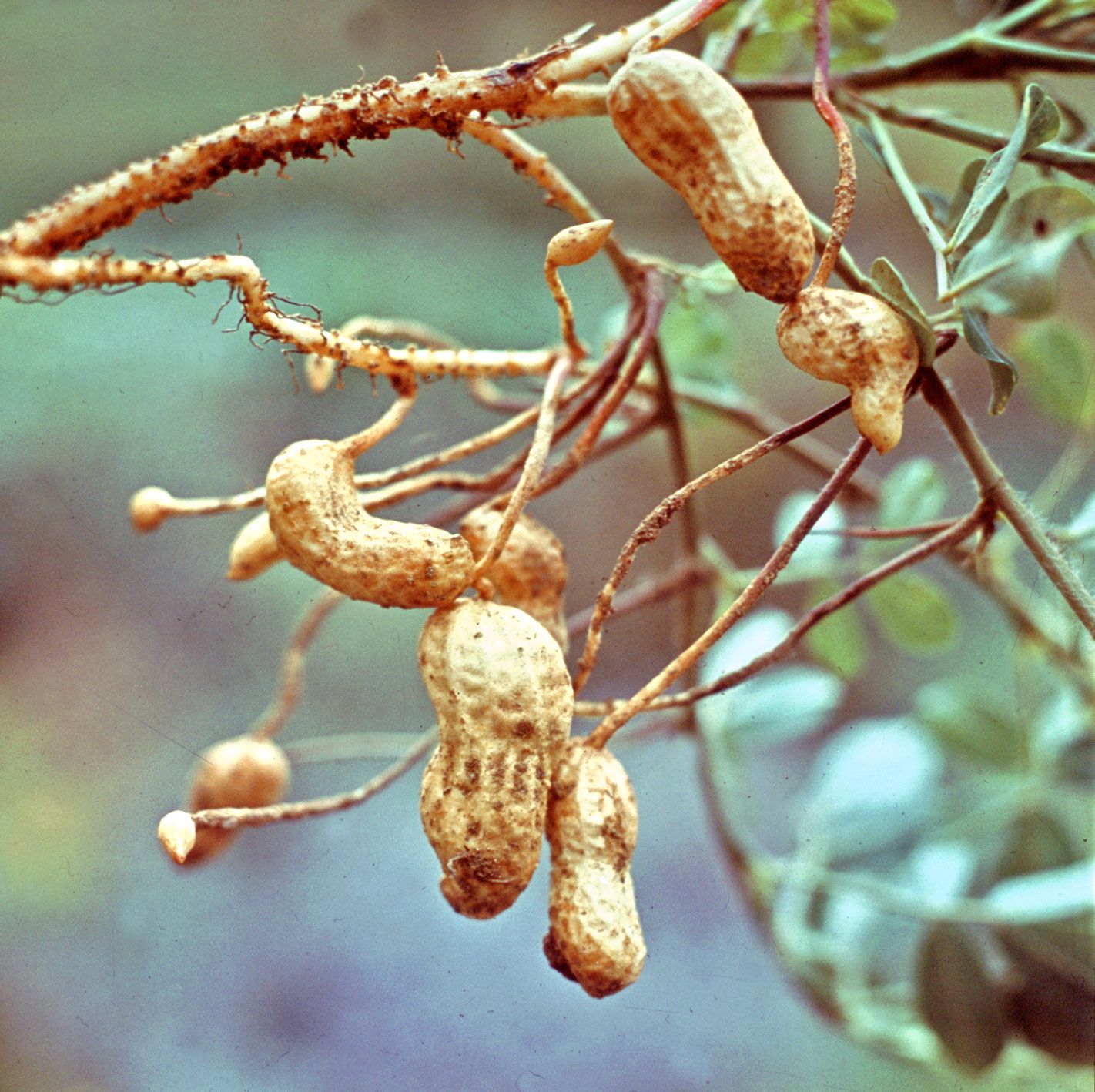You might not believe that until the 1930s, most of the peanut crop in the US was used to feed animals, given how popular they are as a snack. Since the late 1800s, the USDA has been trying to get people to eat them, but it took a while for their work to pay off. Peanuts were eaten in other cultures though, and have been for a long time. Archaeologists have found peanut plants that were grown in Peru more than 7,500 years ago, and explorers in the 1600s saw them being sold as a snack in markets.
Today peanuts are so common that they’re completely unremarkable, but in fact they’re quite unusual plants. One of the most interesting things about them is that they’re not really nuts. To botanists a nut is a seed whose ovary casing has hardened into a protective shell. That sounds like it would include peanuts, but it doesn’t. The shell of a peanut is not at all the ovary casing. This is because peanuts come from a very different place than most nuts.
Most real nuts, like chestnuts and hazelnuts, grow on trees. A lot of other things that most people think of as nuts but don’t really are nuts also grow on trees. Examples of those are pecans, walnuts and almonds. Pine nuts grow on trees, and so do pistachios.
Unlike most nuts, peanuts do not grow on trees. Peanuts are actually legumes related to beans and peas, that grow underground. This unique growing process causes a lot of confusion about where peanuts come from. Let’s take a closer look at the life cycle of the peanut plant to understand how these tasty legumes grow.
Peanuts Are Not Tree Nuts
Tree nuts like almonds, walnuts, pecans, pistachios, and cashews grow on the branches of trees. Their seed pods or fruits mature while attached to the tree. Peanuts belong to a completely different botanical family called Fabaceae, along with beans, lentils, peas, and soybeans.
Peanuts are sometimes called groundnuts or goobers. Their scientific name is Arachis hypogaea. The peanut plant has a bushy low growth habit reaching 1-2 feet tall. Some varieties can grow up to 5 feet tall.
So peanuts do not grow on trees – their short bushes could not support the weight of a mature peanut plant. Peanuts grow underground, which protects the developing seeds and leads to their confusing name.
The Peanut Growth Process
Peanuts have a unique growing cycle compared to other legumes. Here are the key stages of peanut development:
-
Planting – Peanut seeds are planted in the early spring after the last frost. They require sandy, calcium-rich soil and 120-140 frost-free days to reach maturity.
-
Flowering – In early summer, yellow peanut flowers bloom above ground on the plant’s runners or vines. The flowers self-pollinate quickly.
-
Pegging – After the flowers wither, the fertilized ovary at the tip of the runner elongates into a structure called a peg. This peg grows down and penetrates the soil.
-
Pod Development – The tip of the peg begins to swell once buried in the soil. This forms the peanut shell and seeds or kernels. Pods contain 2-4 seeds on average.
-
Maturing – The pods continue swelling underground until the peanuts are mature in fall, Leaving peanuts in the ground too long makes them hard to harvest
So while peanut flowers form above ground in typical legume fashion, the seed pod develops underground. This protects the legume seeds and gives peanuts their misleading name.
Harvesting Peanuts
Since peanuts mature underground, they require specialized harvesting methods. There are two main stages to peanut harvesting:
1. Digging
-
Peanut plants are uprooted either by hand or using mechanized diggers.
-
The digger blades cut the taproot about 1 inch below ground.
-
This leaves the bush and pods exposed at the surface.
2. Picking
-
Plants are picked up and inverted, then laid back down to dry for 3-4 days.
-
The drying allows pods to cure, which improves flavor.
-
Plants are threshed to separate pods from vines.
-
Pods are inspected, cleaned, and graded.
Timing is critical when harvesting peanuts. Waiting too long to dig plants up will cause the pegs to snap off, leaving pods trapped underground. Peanut harvesting requires more labor compared to tree nuts, but it produces a uniquely flavored legume.
Uses for Peanuts
Thanks to their sweet, nutty flavor and rich nutrition, peanuts are a versatile food:
-
Snacking – Roasted, salted peanuts are popular snack food. Peanuts in the shell are also enjoyed at baseball games and other events.
-
Peanut butter – This creamy spread is made by grinding peanuts into paste. Crunchy style has bits of peanut left in.
-
Candy – Peanuts are used in peanut brittle, chocolate-covered peanuts, peanut butter cups, and more sweet treats.
-
Cooking – Peanut oil is valued for high smoke point. Roasted peanuts add texture, flavor, and protein to many savory dishes.
-
Feed – Lower grades of peanut are used as livestock feed. The plants themselves can also be fed as hay.
Peanuts even have non-food uses such as biofuels, cosmetics, and nutritional supplements. Their many benefits make them one of the most versatile legume crops grown worldwide.
So while peanuts may seem like your typical nut, their underground growth habit sets them apart. Next time you enjoy peanut butter or roasted peanuts, remember the unique process that produces these nutritious, tasty legumes. They may not grow on trees, but their flavor is out of this world!
How Do Peanuts Grow?
 Peanuts don’t grow on trees; they come from a plant in the Fabaceae family, just like peas and beans. The hard brown shell peanuts come in is actually a modified peapod. The peanut plant isn’t a tree that produces an annual crop. Instead it’s a small bush, usually planted in late spring. The bushes are generally one to two feet high but some varieties can reach five feet. As the plant grows it develops runners around the base of the stem, and in early summer these runners will bloom with yellow flowers. The flowers are self-fertilizing and don’t last for long; they soon wither and the runners start to droop.
Peanuts don’t grow on trees; they come from a plant in the Fabaceae family, just like peas and beans. The hard brown shell peanuts come in is actually a modified peapod. The peanut plant isn’t a tree that produces an annual crop. Instead it’s a small bush, usually planted in late spring. The bushes are generally one to two feet high but some varieties can reach five feet. As the plant grows it develops runners around the base of the stem, and in early summer these runners will bloom with yellow flowers. The flowers are self-fertilizing and don’t last for long; they soon wither and the runners start to droop.
What happens next is the interesting bit. Most fruits grow from a fertilized flower, but they usually do it in plain sight on the branch. Peanuts do it differently. At the end of each runner, a dried flower sends out a long stalk called a peg. At the very end of this stalk is the fertilized ovary. When the peg touches the ground it pushes down into the soil, anchoring itself firmly. Then the tip starts to swell into a pod, containing two to four seeds. This pod is the peanut shell.
How do peanuts grow? | Natural History Museum
FAQ
Why is growing peanuts illegal?
Are peanuts the only nut that grows in the ground?
Why do peanuts grow underground?
What do peanut plants look like?
How do peanut plants grow?
They grow into a green, oval-leafed plant about 18 inches tall. Unlike most plants, the peanut plant flowers above the ground, but fruits below ground. Yellow flowers emerge around the lower portion of the plant about 40 days after planting. When the flowers pollinate themselves, the petals fall off as the peanut ovary begins to form.
Are peanuts really nuts?
Archaeologists have found cultivated peanuts in Peru that date from over 7,500 years ago and 16 th century explorers found them being sold in markets as a snack. Today peanuts are so common that they’re completely unremarkable, but in fact they’re quite unusual plants. One of the most interesting things about them is that they’re not really nuts.
Do Peanuts grow on trees?
Peanuts don’t grow on trees; they come from a plant in the Fabaceae family, just like peas and beans. The hard brown shell peanuts come in is actually a modified peapod. The peanut plant isn’t a tree that produces an annual crop. Instead it’s a small bush, usually planted in late spring.
Do peanut plants bloom above ground?
The peanut plant appears unremarkable at first glance, but unlike most other plants, its flowers bloom above ground, while its fruits (peanuts) develop below ground. To start, the small yellow flowers grow around the lower portion of the plant, and only last for about a day.
- The Ultimate Guide to Growing Strawberries in Raised Beds - August 8, 2025
- No-Dig Garden Beds: The Easiest Way to Grow a Beautiful Garden - August 6, 2025
- How to Protect and Preserve Wood for Raised Garden Beds - August 6, 2025

